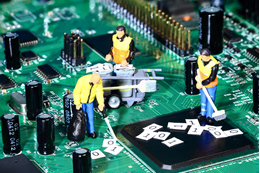Flux-Off Aqueous
Aqueous flux remover for use in ultrasonic cleaning systems
Flux-Off® Aqueous is an extra-strength water based cleaner for flux removal in ultrasonic cleaning systems. It is an excellent cleaner for the removal of all rosin and no clean flux types from electronic sub-assemblies, printed circuit boards and all other electronic components. This concentrated formula can be diluted 1:10 with deionized water for handling all cleaning applications. Flux-Off® Aqueous will effectively remove other contaminants such as dirt, grease, handling soils and molding compounds.
Features & Benefits
- Water-based saponifier for removing all flux types
- For use with ultrasonic cleaning systems
- Removes encrusted, hard, baked fluxes
- Water dilutable
- Nonflammable
- Requires a water rinse
- RoHS compliant
| TDS | |
| REGS | |
| SDS | |
| Categories |
| Shelf Life | 5 yrs. unopened and 2 yrs. opened |
|---|





